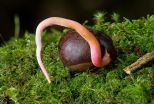New laser therapy helps slow macular degeneration
2014-11-19
(Press-News.org) Researchers from the University of Melbourne found unlike other laser treatments, this new faster laser did not result in damage to the retina, the sensitive light detecting tissue at the back of the eye.
Associate Professor Erica Fletcher from the Department of Anatomy and Neuroscience said this was the first report detailing how this new laser treatment may improve eye health in those with AMD. In the early stages, the disease is characterised by the presence of small fatty deposits called drusen and thickening in a membrane at the back of the eye.
Published this week in Journal of the Federation of American Societies for Experimental Biology (FASEB Journal), the study explores how this laser may help in limiting retinal disease, showing that it improved the health of important supporting cells at the back of the eye.
"These findings suggest treating people with AMD with this new nanosecond laser reduces signs of the disease. Importantly, unlike other lasers currently used to treat eye disease, the nanosecond laser does not result in damage to the sensitive retina," she said.
The study also showed evidence that nanosecond laser treatment in one eye can also produce positive effects in the other untreated eye. This raises the possibility that monocular treatment may be sufficient to treat disease in both eyes.
AMD affects one in seven people over the age of 50 with the incidence increasing in age. It is responsible for 48 per cent of severe vision loss in Australia with an estimated 17,700 new cases each year.
INFORMATION:
This research was conducted in collaboration with the Centre for Eye Research Australia (CERA) through the ongoing Laser intervention in Early Age-related macular Degeneration (LEAD) study.
The laser is manufactured in Australia by Ellex.
ELSE PRESS RELEASES FROM THIS DATE:
2014-11-19
Barcelona, Spain: A new drug that targets not only common cancer-causing genetic mutations in patients with non-small cell lung cancer (NSCLC), but also a form of the mutation that causes resistance to treatment, has shown promising results in patients in a phase I/II clinical trial. The research will be presented today (Friday) at the 26th EORTC-NCI-AACR Symposium on Molecular Targets and Cancer Therapeutics in Barcelona, Spain.
Approximately 10-15% of Caucasian and 30-35% of Asian patients with NSCLC have a mutation in the epidermal growth factor receptor (EGFR), which ...
2014-11-19
If it's help a woman needs, maybe she should wear high heels. That's the message from Nicolas Guéguen of the Université de Bretagne-Sud in France, after he observed how helpful men are towards women in high heels versus those wearing flat, sensible shoes. The study, published in Springer's journal Archives of Sexual Behavior, is the first ever to investigate how the height of a woman's shoe heel influences how men behave towards her.
Research across various cultures has shown at length how important physical features, such as body size and the style and color ...
2014-11-19
Approximately 40 percent of the earth's surface is covered by drylands in which average annual precipitation is lower than evaporation. The changes projected to unfold in these areas in the course of climate change are alarming. Greater variations in annual and seasonal precipitation will lead to more frequent droughts and, presumably, longer drought periods. This means that drylands are among those areas most severely affected by climate change.
Research has thus far not adequately addressed the question of how strongly annual plant growth in pasture landscapes - hence ...
2014-11-19
Time ravages mountains, as it does people. Sharp features soften, and bodies grow shorter and rounder. But under the right conditions, some mountains refuse to age. In a new study, scientists explain why the ice-covered Gamburtsev Mountains in the middle of Antarctica looks as young as they do.
The Gamburtsevs were discovered in the 1950s, but remained unexplored until scientists flew ice-penetrating instruments over the mountains 60 years later. As this ancient hidden landscape came into focus, scientists were stunned to see the saw-toothed and towering crags of much ...
2014-11-19
Researchers from China, the Philippines and LSTM have today published a new systematic review of reminder systems to improve patient adherence to tuberculosis (TB) treatment. Reminder systems include prompts in advance of a forthcoming appointment to help ensure the patients attend, and also actions when people miss an appointment, such as phoning them or arranging a home visit. This review is the latest in a suite of reviews produced by authors from the Cochrane Infectious Diseases Group, hosted at LSTM, evaluating interventions to improve adherence to TB treatment. Effective ...
2014-11-19
Washington, D.C. - November 19, 2014 - Lumosity is presenting new research today at the 2014 Society for Neuroscience conference on how lifestyle factors such as sleep, mood and time of day impact cognitive gameplay performance. The study, titled "Estimating sleep, mood and time of day effects in a large database of human cognitive performance," analyzed over 60 million data points from 61,407 participants and found that memory, speed, and flexibility tasks peaked in the morning, while crystallized knowledge tasks such as arithmetic and verbal fluency peaked in the afternoon. ...
2014-11-19
An international team of scientists, coordinated by a researcher from the U. of Granada, has found that seed dormancy (a property that prevents germination under non-favourable conditions) was a feature already present in the first seeds, 360 million years ago.
Seed dormancy is a phenomenon that has intrigued naturalists for decades, since it conditions the dynamics of natural vegetation and agricultural cycles. There are several types of dormancy, and some of them are modulated by environmental conditions in more subtle ways than others.
In an article published in the ...
2014-11-19
Quasars are galaxies with very active supermassive black holes at their centres. These black holes are surrounded by spinning discs of extremely hot material that is often spewed out in long jets along their axes of rotation. Quasars can shine more brightly than all the stars in the rest of their host galaxies put together.
A team led by Damien Hutsemékers from the University of Liège in Belgium used the FORS instrument on the VLT to study 93 quasars that were known to form huge groupings spread over billions of light-years, seen at a time when the Universe ...
2014-11-19
PROVIDENCE, R.I. [Brown University] -- A widely presumed problem of aging is that the brain becomes less flexible -- less plastic -- and that learning may therefore become more difficult. A new study led by Brown University researchers contradicts that notion with a finding that plasticity did occur in seniors who learned a task well, but it occurred in a different part of the brain than in younger people.
When many older subjects learned a new visual task, the researchers found, they unexpectedly showed a significantly associated change in the white matter of the brain. ...
2014-11-19
Professor Dan Davis and his team at the Manchester Collaborative Centre for Inflammation Research, working in collaboration with global healthcare company GSK, investigated how different types of immune cells communicate with each other - and how they kill cancerous or infected cells. Their research has been published in Nature Communications.
Professor Davis says: "We studied the immune system and then stumbled across something that may explain why some drugs don't work as well as hoped. We found that immune cells secrete molecules to other cells across a very small ...
LAST 30 PRESS RELEASES:
[Press-News.org] New laser therapy helps slow macular degeneration


